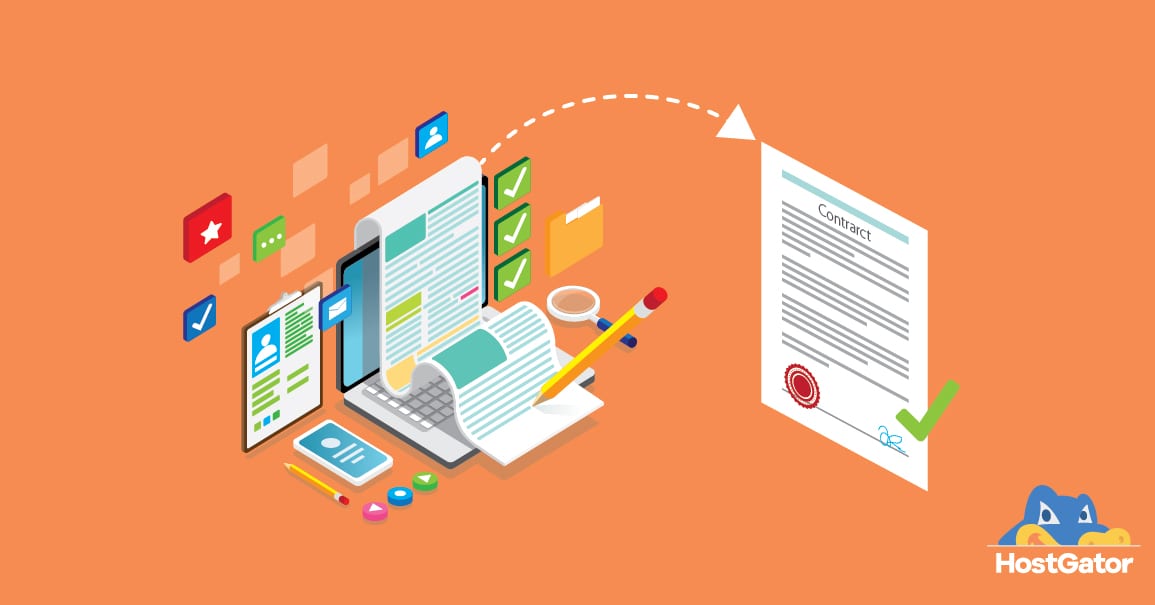Even before the COVID-19 pandemic, handfuls of workers left their 9-5 jobs to start freelance businesses.
As of 2019, 7 million Americans worked in the freelance economy. Reports show these freelancers were earning more per hour than 70% of the workers in the U.S. economy.
Since the advent of the pandemic, the number of freelance businesses has skyrocketed. New studies show over two million Americans started freelancing during the pandemic, which increases the proportion of the workforce that freelances to a whopping 36%.
With more freelance workers in the global talent pool, there is now more competition for contract jobs. If you’re going to stand out in the crowd, the way to do it is to make an excellent first impression with your proposal.
This post will cover everything you need to know about why you should start submitting freelance proposals and how to write them.
Why should you submit a freelance proposal?
As a quick review, a freelance proposal is a professional document you send a potential client. The proposal outlines the scope of the project, the services you offer, the client’s investment, and details any other relevant information pertaining to the job.
Writing a good freelance proposal can mean the difference between landing a client and getting your application tossed to the side.
When you write a good proposal, it shows:
- You’re a credible professional with ironed out business processes
- You care enough about the project to put together a custom plan
- You understand the needs and goals of your customer
- How your services are the perfect match for the job
- What results you can generate for your client
- What you’ve done in the past for similar clients
Freelancer, Nia Gyant, sums up the reason every contract worker should write a proposal. Gyant says, “Proposals indicate confidence that my work can make a difference for a business. Often, that difference has tangible and intangible aspects ranging from conversions to enhanced credibility for the client. If I don’t see how I can achieve those, I don’t prepare a proposal.”
How to write an outstanding freelance proposal
Now that we’ve talked about why to submit a freelance proposal, let’s talk about how to create a proposal that will help you secure your new freelance client. We’ll cover:
- The essential parts of a good proposal
- Proposal writing best practices
1. What are the main components of a proposal?
If you’re writing a proposal for the first time, you must include some key information every time.
Every proposal should include:
- Your contact information. Your contact information includes your name, business name, address, logo, email address, phone number, and website.
- Client information. The client’s name, company, company address, and email address.
- Significant numbers and dates. Proposals are a formal document and should include a client number, proposal number, the date you sent the proposal, and the date the client needs to accept or decline your proposal.
How you structure the main sections of the rest of your proposal may vary slightly depending on your industry, but here are the most standard sections to include.
1. Overview/introduction letter
The first page of your freelance proposal is a brief overview of your proposal. Most freelancers make it personal by writing a short letter to the client.
Keep this letter short and sweet and use it as a tool to:
- Reintroduce yourself after you’ve had your first call
- Reiterate the details of the project
- Quickly explain your understanding of the project
- Provide an overview of what you include in the proposal
- Thank the client
Remember, every client is different, and it’s essential to customize your proposal, but here is a template you can reference to help you kick-start your proposal overview.
Hello [Client],
Thank you for taking the time to speak with me about [quick description of the project] for [name of the company].
I look forward to [description of what you will do for the client].
This proposal includes information about the scope of work, your investment, and a contractor agreement for your review.
Thank you for your consideration!
[Your Name]
2. Project description or scope of services
Dedicate the second page of your proposal to the project description and the scope of your services.
Start by defining the problem the customer is currently experiencing. If you have any data that highlights the problem, include it in your proposal. Another approach is to re-state the project goals your potential client communicated to you earlier.
Once you’ve discussed the problem and customer goals, you want to showcase your solution. In other words, you’ll want to tell your potential client everything you plan to do to solve their current problem or meet their project goals.
For example, if you’re a freelance web designer, your scope of services may include a paragraph-long description of the following steps:
- Research
- Design
- Development
- WordPress integration
Since you’re defining the scope of the project, make sure to be explicit about exactly what you will and will not do. This way, you avoid scope creep and don’t end up doing additional work you’re not being paid to do.
A quick tip: If you offer additional services that would help your customer reach their business goals, add an “additional service recommendations” section to your proposal. For example, a freelance web designer could add “user testing” and “support retainer.”
3. Timeframe
Clients also want to know how long it will take you to complete a project. The timeline section of your proposal is where you break down critical milestones into a timeline.
For example, if you’re planning to develop a new client website, you should tell them how long you anticipate the total project will take. Then, break the timeline down into milestones.
Let’s say it takes you 12 weeks to develop a website. Here are some milestones and reasonable timelines you could include in your proposal.
12 Week WordPress Site Development Timeline:
- Weeks 1 & 2: Research
- Week 3: Present wireframes
- Weeks 4 & 5: Present finished mockups
- Weeks 6 & 7: Code HTML/CSS templates
- Weeks 8 & 9: WordPress theme integration
- Weeks 10 & 11: QA testing and review
- Week 12: Deployment to live site
A timeline shows the customer exactly what they are getting from you and when.
4. Investment
No one likes to talk about money, but the “investment” section is one of the most critical pieces of the proposal puzzle. Your client wants to know how much it will cost, and you want to make sure you get paid for the work you are doing.
In this section, detail how much each of your services costs. You can include a core budget, which is the prices of the services they are specifically requesting.
If you’ve suggested additional services, then include a separate section for the prices of add-on services.
5. Information about why the client should select you for the project
The following few sections vary widely from freelancer-to-freelancer and industry-to-industry. What you end up including will depend on the project, your personal preference, your industry, and the client.
Some freelancers include a “Why Me” section that offers more information about your professional talents, notable results, and work philosophy.
Other freelancers include testimonials. Freelancer Sally Fox uses this approach in her proposals. Fox says the way to make a foolproof proposal is to “include a testimonial from a past client. It adds credibility and allows you to show your skills and experience.”
A similar approach is to include a relevant case study about how you’ve achieved results for similar clients.
Case study writer and founder of Stories By Us, Emma Siemasko, says “When you send a proposal, you want to seal the deal. So, share a case study within your proposal! The case study shows the client the transformation that’s possible when they work with you. It shows a real-life example of your results, which will encourage the client to say ‘yes’ to what you’ve proposed. It’s not enough to simply lay out the work you’ll do for a client–you need to showcase how you’ve helped others.”
Whatever your approach, make sure you address why you’re the best person for the job.
6. Contract
Every freelance proposal should include a contractor agreement. A contract is a legal promise between you and your client. You promise to send the deliverables as agreed, and your client promises to pay you.
A contract will help you cover your legal bases and will protect you in the event of a lawsuit.
Ashley Garbe Smith, the founder of AGS Law and a stellar contract lawyer, says, “A contractor agreement is an essential business protection tool every freelancer should be using with every client. It helps you get paid for your work. It’s also a great reference guide that clarifies each party’s obligations and your scope of work if there is ever any question.”
Not only does a contract help you protect your backside, but it also lends credibility to your freelance business.
A quick tip: It’s wise to consult with a contract lawyer to draw up a unique contract for your business. There are also several lawyer-written and peer-reviewed customizable agreements available to freelancers. If you can’t afford to hire a lawyer, paying a one-time fee for one of these customizable contracts is a much better idea than relying on the random template in your proposal software.
Freelance proposal writing best practices
Including all the right sections in your proposal is only half the battle when it comes to writing an excellent freelance proposal. Here are some additional tips that will help you create a custom proposal with every new potential client that screams, “hire me.”
1. Talk to your clients before you write a proposal. It takes time to write a proposal, and you want to make sure you get it right. A quick client introduction call will allow you to ask questions, understand your client’s pain points, and get a good feel for what services the client needs.
2. Do your research. The more you know about your client’s business and industry, the more likely you are to secure the project. Take the time to research your client and their industry. This will help you learn how you can help the client.
3. Personalize your proposal. There is absolutely nothing wrong with using a template for your proposals. A template can help guide you through the writing process and ensure you don’t miss important points. However, make sure you customize everything for each client.
4. Talk about the client, not yourself. Freelancer, Dan Kenitz, says writing a good proposal means talking about your clients. He says, “I have had success recently switching to ‘what I can do for you’ upfront rather than ‘I/me’ sentences. Since then, I’ve received multiple offers and compliments for my proposal standing out.”
5. Use proposal software. One of the most challenging things about being a freelancer is staying organized. Not only do you have to complete client work, but you have to do all the administrative work in your business. A proposal software will help you create beautiful proposals and keep track of them.
As you implement freelance proposal best practices, you’ll create proposals that hit the mark and help you land the client every time.
Start your freelance website with Virtue Media today
If you’re ready to join the ranks of the 36% of people that are freelancing, remember the first step is to get your freelance website up and running.
Virtue Media has a wide variety of excellent web hosting options. Check out our web hosting plans today!



![How to Create Your Freelance Brand [5-Step Guide]](https://mdvirtue.com/wp-content/uploads/2022/02/How-to-Create-Your-Freelance-Brand-5-Step-Guide-400x250.jpeg)
![How to Build a Coaching Website on WordPress [Expert Guide]](https://mdvirtue.com/wp-content/uploads/2022/02/How-to-Build-a-Coaching-Website-on-WordPress-Expert-Guide-400x250.jpeg)

0 Comments